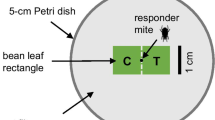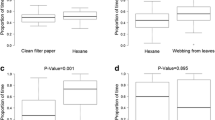Abstract
The silk produced by the group-living mite Tetranychus urticae provides group protection and is used as an informative material during habitat settlement, egg laying, mating, and dispersal events. In this context, cues contained in the silk and other materials produced by mites [eggs, black faeces (BF) and white faeces + silk (WFS)] were investigated. Chemical compounds were extracted by hexane or methanol, and choice tests were used to determine the individual attractiveness of each extract. For both solvents, individuals did not respond to the extract from eggs and WFS. BF extracts were attractive for both solvents. After separating the BF methanol extract into four different chemical components using thin layer chromatography, no component was determined to be responsible for mite attraction. This work supports the evidence that the faeces of T. urticae do contain substances that promote behavioural changes. Not particular chemical compounds but combinations of them seem to induce the mites’ preference. Moreover, the response of mites to chemicals seemed to be context dependent as mites belonging to populations with different densities differed in their attraction to BF extracts.




Similar content being viewed by others
References
Bolland HR, Flechtman CHW, Gutierrez J (1998) World catalogue of the spider mite family (Acari: Tetranychidae). Brill Academic Publishers, Leiden
Borden JH (1974) Aggregation pheromones in the Scolytidae. In: Birch MC (ed) Pheromones. North Holland Publ. Co., Amsterdam, pp 135–160
Cardé RT, Minks AK (1995) Control of moth pests by mating disruption: successes and constraints. Annu Rev Entomol 40:559–585
Clotuche G (2011) The silk as a thread to understand social behaviour in the weaving mite Tetranychus urticae. Dissertation, University of Louvain-la-Neuve, Belgium
Clotuche G, Le Goff G, Mailleux AC, Deneubourg JL, Detrain C, Hance T (2009) How to visualize the spider mite silk? Microsc Res Tech 72:659–664
Clotuche G, Mailleux AC, Fernandez AA, Deneubourg JL, Detrain C, Hance T (2011) The formation of collective silk-balls in the spider mite Tetranychus urticae Koch. PLoS One 6:e18854
Clotuche G, Deneubourg JL, Mailleux AC, Detrain C, Hance T (2012) Discrimination through silk recognition: the case of the two-spotted spider mite Tetranychus urticae. CR Biol 335:535–540
Clotuche G, Mailleux AC, Yano S, Detrain C, Deneubourg JL, Hance T (2013) Settlement decisions by the two-spotted spider mite Tetranychus urticae. CR Biol 336:93–101
Cone WW, Predki S, Klostermeyer EC (1971) Pheromone studies of the two-spotted spider mite. 2. Behavioral response of males to quiescent deutonymphs. J Econ Entomol 64:379–382
Costa JT (2006) The other insect societies. The Belknap Press of Harvard University Press, USA
Gerson U (1985) Webbing. In: Helle W, Sabelis MW (eds) Spider mites, their biology, natural enemies and control, vol 1A. Elsevier, Amsterdam, pp 223–233
Hazan A, Gertler A, Tahori AS, Gerson U (1975) Spider mite webbing III. Solubilization and amino acid composition of the silk protein. Comp Biochem Physiol 51B:457–462
Howse P, Stevens JM, Yones O (1998) Insect pheromones and their use in pest management. Chapman & Hall, London
Hoy M, Smilanick JM (1981) Non random prey location by the phytoseiid predator Metaseiulis occidentalis: differential responses to several spider mite species. Entomol Exp Appl 29:241–253
Jeanson R, Deneubourg JL (2007) Conspecific attraction and shelter selection in gregarious insects. Am Nat 170:47–58
Jeppson LR, Keifer HH, Baker EW (1975) Mites injurious to economic plants. University California Press, Berkeley
Le Goff G (2011) Benefits of aggregation in Tetranychus urticae. Dissertation, University of Louvain-la-Neuve, Belgium
Le Goff G, Mailleux AC, Detrain C, Deneubourg JL, Clotuche G, Hance T (2010) Group effect on fertility, survival and silk production in the web spinner Tetranychus urticae (Acari: Tetranychidae) during colony foundation. Behaviour 147:1169–1184
Migeon A, Dorkeld F (2006-2010) Spider mites web: a comprehensive database for the Tetranychidae. http://www.montpellier.inra.fr/CBGP/spmweb
Oku K, Magalhaes M, Dicke M (2009) The presence of webbing affects the oviposition rate of the two-spotted spider mites, Tetranychus urticae (Acari: Tetranychidae). Exp Appl Acarol 49:167–172
Penman DR, Cone WW (1974) Role of web, tactile stimuli and female sex pheromone in attraction of male two-spotted spider mites to quiescent female deutonymphs. Ann Entomol Soc Am 67:179–182
Sabelis MW, Van De Baan HE (1983) Location of distant spider mite colonies by phytoseiid predators: demonstration of specific kairomones emitted by Tetranychus urticae and Panonychus ulmi. Entomol Exp Appl 33(3):303–314
Saito Y (2009) Plant mites and sociality, diversity and evolution. Springer, Tokyo
Van Leeuwen T, Vanholme B, Van Pottelberge S, Van Nieuwenhuyse P (2008) Mitochondrial heteroplasmy and the evolution of insecticide resistance: non-Mendelian inheritance in action. Proc Natl Acad Sci USA 105(16):5980–5985
Van Leeuwen T, Vontas J, Tsagkarakou A, Dermauw W, Tirry L (2010) Acaricide resistance mechanisms in the two-spotted spider mite Tetranychus urticae and other important Acari: a review. Insect Biochem Mol Biol 40:563–572
Wertheim B, Van Baalen EJA, Dicke M, Vet LEM (2005) Pheromone-mediated aggregation in nonsocial arthropods: an evolutionary ecological perspective. Annu Rev Entomol 50:321–346
Wyatt TD (2003) Pheromones and animal behaviour: communication by smell ant taste. Cambridge University Press, UK
Yano S (2008) Collective and solitary behaviors of two-spotted spider mite (Acari: Tetranychidae) are induced by trail following. Ann Entomol Soc Am 101:247–252
Yano S (2012) Cooperative web sharing against predators promotes group living in spider mites. Behav Ecol Sociobiol 66:845–853
Yano S, Osakabe M (2009) Do spider mite-infested plants and spider mite trails attract predatory mites? Ecol Res 24:1173–1178
Acknowledgments
We thank Prof. Osakabe from Kyoto University for his help during laboratory work. We are grateful to the team of the Ecological Information Laboratory (Kyoto University) and the team of Chemical Ecology Laboratory (Kyoto Institute of Technology). This work was supported by Japan Society for the Promotion of Science (J.S.P.S Postdoctoral Fellowship for North American and European Researchers to G. C) and party supported by the Japan Society for the Promotion of Science (Basic Research C, Grant Number 21580066 to S. Y. and T. A.
Author information
Authors and Affiliations
Corresponding author
Rights and permissions
About this article
Cite this article
Clotuche, G., Yano, S., Akino, T. et al. Chemical investigation of aggregation behaviour in the two-spotted spider mite Tetranychus urticae . Exp Appl Acarol 63, 377–387 (2014). https://doi.org/10.1007/s10493-014-9779-x
Received:
Accepted:
Published:
Issue Date:
DOI: https://doi.org/10.1007/s10493-014-9779-x




